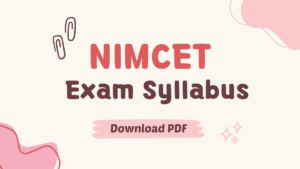The COMEDK UGET examination schedule has been released by the authority. The COMEDK UGET 2025 exam is scheduled for May 10. With this engineering exam approaching, candidates should begin their serious preparation by preparing all the topics mentioned in COMEDK UGET 2025 syllabus.
The Consortium of Medical, Engineering and Dental Colleges of Karnataka issues the COMEDK UGET syllabus in the information brochure released along with the application form. So, the COMEDK 2025 syllabus will likely be made available on February 03, 2025.
COMEDK UGET 2025 Syllabus
The COMEDK syllabus 2025 will be published on the official website: www.comedk.org. The COMEDK UGET syllabus 2025 contains all the important topics that needs to be prepared for this state-level engineering entrance exam. The COMEDK Under Graduate Entrance Test (UGET) 2025 syllabus is divided into three subjects: Physics, Chemistry and Mathematics. Candidates should consult only the official syllabus while preparing for the COMEDK UGET 2025 exam.
COMEDK UGET Syllabus Overview
The COMEDK UGET syllabus consists of questions from the PUC I and PUC II level of the KSEAB. It is important to note that the COMEDK UGET exam consists of only objective type questions. For effective preparation, candidates must prepare every chapter mentioned in the syllabus. The overview of the COMEDK UGET syllabus is given below.
| Particulars | Details |
| Name of the Exam | COMEDK UGET 2025 |
| Full Name | Consortium of Medical, Engineering, and Dental Colleges of Karnataka Under Graduate Entrance Test |
| Conducting Body | Consortium of Medical, Engineering, and Dental Colleges of Karnataka (COMEDK) |
| Category | Syllabus |
| COMEDK Syllabus 2025 Status | To be out soon |
| COMEDK UGET 2025 Syllabus PDF Release Date | February 03, 2025 (expected) |
| COMEDK UGET Syllabus 2025 PDF Release Mode | Online |
| COMEDK UGET 2025 Exam Date | May 10, 2025 |
| Total Number of Sections in COMEDK UGET 2025 Syllabus | 3 Sections |
| COMEDK 2025 Syllabus Subjects | Physics, Chemistry, Mathematics |
| COMEDK UGET 2025 Syllabus Official Website | www.comedk.org |
COMEDK 2025 Syllabus Subject-wise
COMEDK will soon release the syllabus for UGET 2025. In the meantime, learners can consult the COMEDK syllabus 2024 in the sections provided below. Any changes, whether additions or deletions, to the syllabus will be promptly reflected here.
Candidates familiar with the complete COMEDK syllabus 2025 for engineering will have an advantage over their peers. It will assist in creating a productive study strategy while getting ready for the Karnataka UGET exam 2025. View the COMEDK UGET syllabus subject-wise here.
COMEDK Physics Syllabus 2025
The Physics Syllabus for COMEDK UGET 2025 comprises key concepts and theories. It offers a comprehensive grasp of physical concepts and events, equipping students for multiple competitive assessments.
| Unit Number | Unit Name | Topics included in the syllabus |
| PUC 1st Year | ||
| Unit I | Physical World and Measurement | Units and Measurements: Need for measurement, systems of units, SI units, fundamental and derived units, Significant figures, Dimensions of physical quantities, dimensional analysis, and its applications. |
| Unit II | Kinematics | Motion in a Straight Line: Frame of reference, Motion in a straight line, Elementary concepts of differentiation and integration for describing motion, Uniform and non-uniform motion, average speed and instantaneous velocity, Uniformly accelerated motion, velocity-time and position-time graphs, Relations for uniformly accelerated motion (graphical treatment). , Motion in a Plane: Scalar and vector quantities, Position and displacement vectors, general vectors and their notations, equality of vectors, multiplication of vectors by a real number, addition and subtraction of vectors, Unit vector, Resolution of a vector in a plane – rectangular components, Scalar and Vector product of vectors, Motion in a plane, Cases of uniform velocity and uniform acceleration, projectile motion, Uniform circular motion. |
| Unit III | Laws of Motion | Intuitive concept of force, Inertia, Newton’s first law of motion, momentum and Newton’s second law of motion, impulse, Newton’s third law of motion, Law of conservation of linear momentum and its applications, Equilibrium of concurrent forces, Static and kinetic friction, laws of friction, rolling friction, lubrication, Dynamics of uniform circular motion: Centripetal force, examples of circular motion (vehicle on a level circular road, vehicle on a banked road). |
| Unit IV | Work, Energy, and Power | Work done by a constant force and a variable force, kinetic energy, work-energy theorem, power, Notion of potential energy, potential energy of a spring, conservative forces: non-conservative forces, motion in a vertical circle, elastic and inelastic collisions in one and two dimensions. |
| Unit V | Motion of System of Particles and Rigid Body | Centre of mass of a two-particle system, momentum conservation and centre of mass motion, Centre of mass of a rigid body, centre of mass of a uniform rod, Moment of a force, torque, angular momentum, laws of conservation of angular momentum and its applications, Equilibrium of rigid bodies, rigid body rotation and equations of rotational motion, comparison of linear and rotational motions, Moment of inertia, radius of gyration, Values of moments of inertia for simple geometrical objects (no derivation). |
| Unit VI | Gravitation | Kepler’s laws of planetary motion, The universal law of gravitation, Acceleration due to gravity and its variation with altitude and depth, Gravitational potential energy and gravitational potential, Escape velocity, and Orbital velocity of a satellite. |
| Unit VII | Properties of Bulk Matter | Mechanical Properties of Solids: Elastic behavior, Stress-strain relationship, Hooke’s law, Young’s modulus, bulk modulus, shear modulus of rigidity (qualitative idea only), Poisson’s ratio, elastic energy. , Mechanical Properties of Fluids: Pressure due to a fluid column, Pascal’s law and its applications (hydraulic lift and hydraulic brakes), Effect of gravity on fluid pressure, Viscosity, Stokes’ law, terminal velocity, streamline and turbulent flow, critical velocity, Bernoulli’s theorem and its simple applications, Surface energy and surface tension, angle of contact, excess of pressure across a curved surface, application of surface tension ideas to drops, bubbles and capillary rise. , Thermal Properties of Matter: Heat, temperature, thermal expansion; thermal expansion of solids, liquids and gases, Anomalous expansion of water, specific heat capacity, Cp, Cv – calorimetry, change of state – latent heat capacity, Heat transfer-conduction, convection, and radiation, thermal conductivity, Qualitative ideas of Blackbody radiation, Wein’s displacement Law, Stefan’s law. |
| Unit VIII | Thermodynamics | Thermal equilibrium and definition of temperature (zeroth law of thermodynamics), Heat, work, and internal energy, First law of thermodynamics, Second law of thermodynamics: gaseous state of matter, change of condition of gaseous state – isothermal, adiabatic, reversible, irreversible, and cyclic processes. |
| Unit IX | Behaviour of Perfect Gases and Kinetic Theory of Gases | Equation of state of a perfect gas, work done in compressing a gas, Kinetic theory of gases – assumptions, the concept of pressure, Kinetic interpretation of temperature, rms speed of gas molecules, degrees of freedom, the law of equipartition of energy (statement only) and application to specific heat capacities of gases, the concept of mean free path, Avogadro’s number. |
| Unit X | Oscillations and Waves | Oscillations: Periodic motion – time period, frequency, displacement as a function of time, Periodic functions and their application, Simple harmonic motion (S.H.M) and its equation, phase, oscillations of a loaded spring-restoring force and force constant, energy in S.H.M. Kinetic and potential energies, simple pendulum derivation of expression for its time period. , Waves: Wave motion, Transverse and longitudinal waves, speed of travelling wave, Displacement relation for a progressive wave, Principle of superposition of waves, reflection of waves, standing waves in strings and organ pipes, fundamental mode and harmonics, Beats. |
| PUC 2nd Year | ||
| Unit I | Electrostatics | Electric Charges and Fields: Electric Charges, Conservation of charge, Coulomb’s law force between two point charges, forces between multiple charges, superposition principle and continuous charge distribution, Electric field, electric field due to a point charge, electric field lines, electric dipole, electric field due to a dipole, torque on a dipole in uniform electric field, Electric flux, statement of Gauss’s theorem and its applications to find field due to infinitely long straight wire, uniformly charged infinite plane sheet and uniformly charged thin spherical shell (field inside and outside). , Electrostatic Potential and Capacitance: Electric potential, potential difference, electric potential due to a point charge, a dipole and system of charges, equipotential surfaces, the electrical potential energy of a system of two point charges and of electric dipole in an electrostatic field, Conductors and insulators, free charges and bound charges inside a conductor, Dielectrics and electric polarization, capacitors and capacitance, combination of capacitors in series and in parallel, capacitance of a parallel plate capacitor with and without dielectric medium between the plates, energy stored in a capacitor (no derivation, formulae only). |
| Unit II | Current Electricity | Electric current, flow of electric charges in a metallic conductor, drift velocity, mobility and their relation with electric current, Ohm’s law, V-I characteristics (linear and non-linear), electrical energy and power, electrical resistivity and conductivity, temperature dependence of resistance, Internal resistance of a cell, potential difference and emf of a cell, combination of cells in series and in parallel, Kirchhoff’s laws, Wheatstone bridge. |
| Unit III | Magnetic Effects of Current and Magnetism | Moving Charges and Magnetism: Concept of the magnetic field, Oersted’s experiment, Biot-Savart law and its application to current carrying circular loop, Ampere’s law and its applications to an infinitely long straight wire, Straight solenoid (only qualitative treatment), Force on a moving charge in uniform magnetic and electric fields, Force on a current-carrying conductor in a uniform magnetic field, Force between two parallel current-carrying conductors – definition of ampere, Torque experienced by a current loop in uniform magnetic field, Current loop as a magnetic dipole and its magnetic dipole moment, Moving coil galvanometer – its current sensitivity and conversion to ammeter and voltmeter. , Magnetism and Matter: Bar magnet, bar magnet as an equivalent solenoid (qualitative treatment only), Magnetic field intensity due to a magnetic dipole (bar magnet) along its axis and perpendicular to its axis (qualitative treatment only), Torque on a magnetic dipole (bar magnet) in a uniform magnetic field (qualitative treatment only), magnetic field lines, Magnetic properties of materials-Para-, dia- and ferromagnetic substances with examples, Magnetization of materials, effect of temperature on magnetic properties. |
| Unit IV | Electromagnetic Induction and Alternating Currents | Electromagnetic Induction: Faraday’s laws, induced EMF and current, Lenz’s Law, Self and mutual induction. , Alternating Current: Alternating currents, peak and rms value of alternating current/voltage, reactance and impedance, LCR series circuit (phasors only), resonance, power in AC circuits, wattless current, AC generator, and Transformer. |
| Unit V | Electromagnetic Waves | Basic idea of displacement current, Electromagnetic waves and their characteristics, Transverse nature of electromagnetic waves (Qualitative ideas only), Electromagnetic spectrum (radio waves, microwaves, infrared, visible, ultraviolet, X-rays, gamma rays) including elementary facts about their uses. |
| Unit VI | Optics | Ray Optics and Optical Instruments: Ray Optics: Reflection of light, spherical mirrors, mirror formula, Refraction of light, total internal reflection and optical fibres, refraction at spherical surfaces, lenses, thin lens formula, lens maker’s formula, Magnification, power of a lens, a combination of thin lenses in contact, Refraction of light through a prism. , Optical Instruments: Microscopes and astronomical telescopes (reflecting and refracting) and their magnifying powers. , Wave Optics: Wavefront and Huygens principle, reflection and refraction of plane wave at a plane surface using wavefronts, Proof of laws of reflection and refraction using Huygens principle, Interference, Young’s double slit experiment and expression for fringe width (No derivation final expression only), coherent sources and sustained interference of light, Diffraction due to a single slit, width of central maximum (qualitative treatment only). |
| Unit VII | Dual Nature of Matter and Radiation | Dual nature of radiation: Photoelectric effect, Hertz and Lenard’s observations, Einstein’s photoelectric equation – particle nature of light, Experimental study of photoelectric effect. , Matter waves: Wave nature of particles, de Broglie relation. |
| Unit VIII | Atoms & Nuclei | Atoms: Alpha-particle scattering experiment, Rutherford’s model of an atom, Bohr model of a hydrogen atom, Expression for radius of nth possible orbit, velocity and energy of the electron in this orbit, hydrogen line spectra (qualitative treatment only). , Nuclei: Composition and size of nucleus, nuclear force, Mass-energy relation, mass defect, binding energy per nucleon and its variation with mass number, nuclear fission, nuclear fusion. |
| Unit IX | Electronic Devices | Semiconductor Electronics: Materials, Devices and Simple Circuits: Energy bands in solids, conductors, insulators and semiconductors (Qualitative ideas only), Intrinsic and extrinsic semiconductors – p and n type, p-n junction, Semiconductor diode – I-V characteristics in forward and reverse bias, application of junction diode – diode as a rectifier. |
COMEDK UGET Syllabus 2025 for Chemistry
The Chemistry Syllabus for COMEDK UGET 2025 encompasses topics from both organic and inorganic chemistry. It guarantees that students acquire comprehensive understanding of chemical reactions, substances, and laboratory methods.
| Unit Number | Unit Name | Syllabus Topics |
| PUC I Year | ||
| Unit 1 | Some Basic Concepts of Chemistry | General Introduction: Importance and scope of Chemistry, Nature of matter, laws of chemical combination, Dalton’s atomic theory: concept of elements, atoms and molecules, Atomic and molecular masses, mole concept and molar mass, percentage composition, empirical and molecular formula, chemical reactions, stoichiometry, and calculations based on stoichiometry. |
| Unit 2 | Structure of Atom | Discovery of Electron, Proton, and Neutron, atomic number, isotopes and isobars, Thomson’s model and its limitations, Rutherford’s model and its limitations, Bohr’s model and its limitations, concept of shells and subshells, dual nature of matter and light, de Broglie’s relationship, Heisenberg uncertainty principle, concept of orbitals, quantum numbers, shapes of s, p, and d orbitals, rules for filling electrons in orbitals – Aufbau principle, Pauli’s exclusion principle, and Hund’s rule, electronic configuration of atoms, stability of half-filled and completely filled orbitals. |
| Unit 3 | Classification of Elements and Periodicity in Properties | Significance of classification, brief history of the development of the periodic table, modern periodic law and the present form of the periodic table, periodic trends in properties of elements – atomic radii, ionic radii, inert gas radii, Ionization enthalpy, electron gain enthalpy, electronegativity, valency, Nomenclature of elements with atomic number greater than 100. |
| Unit 4 | Chemical Bonding and Molecular Structure | Valence electrons, ionic bond, covalent bond, bond parameters, Lewis’s structure, polar character of covalent bond, covalent character of ionic bond, valence bond theory, resonance, geometry of covalent molecules, VSEPR theory, concept of hybridization involving s, p, and d orbitals and shapes of some simple molecules, molecular orbital theory of homonuclear diatomic molecules (qualitative idea only), Hydrogen bond. |
| Unit 5 | Chemical Thermodynamics | Concepts of System and types of systems, surroundings, work, heat, energy, extensive and intensive properties, state functions, First law of thermodynamics – internal energy and enthalpy, heat capacity and specific heat, measurement of ΔU and ΔH, Hess’s law of constant heat summation, enthalpy of bond dissociation, combustion, formation, atomization, sublimation, phase transition, ionization, solution and dilution, Second law of Thermodynamics (brief introduction), Introduction of entropy as a state function, Gibb’s energy change for spontaneous and non-spontaneous processes, criteria for equilibrium, Third law of thermodynamics (brief introduction). |
| Unit 6 | Equilibrium | Equilibrium in physical and chemical processes, dynamic nature of equilibrium, law of mass action, equilibrium constant, factors affecting equilibrium – Le Chatelier’s principle, ionic equilibrium – ionization of acids and bases, strong and weak electrolytes, degree of ionization, ionization of polybasic acids, acid strength, concept of pH, hydrolysis of salts (elementary idea), buffer solution, Henderson Equation, solubility product, common ion effect (with illustrative examples). |
| Unit 7 | Redox Reactions | Concept of oxidation and reduction, redox reactions, oxidation number, balancing redox reactions, in terms of loss and gain of electrons and change in oxidation number, applications of redox reactions. |
| Unit 8 | Organic Chemistry – Some Basic Principles and Techniques | General introduction, methods of purification, qualitative and quantitative analysis, classification and IUPAC nomenclature of organic compounds, Electronic displacements in a covalent bond: inductive effect, electromeric effect, resonance, and hyperconjugation, Homolytic and heterolytic fission of a covalent bond: free radicals, carbocations, carbanions, electrophiles and nucleophiles, types of organic reactions. |
| Unit 9 | Hydrocarbons | Classification of Hydrocarbons: , Aliphatic Hydrocarbons: Alkanes – Nomenclature, isomerism, conformation (ethane only), physical properties, chemical reactions including free radical mechanism of halogenation, combustion and pyrolysis. Alkenes – Nomenclature, structure of double bond (ethene), geometrical isomerism, physical properties, methods of preparation, chemical reactions: addition of hydrogen, halogen, water, hydrogen halides (Markovnikov’s addition and peroxide effect), ozonolysis, oxidation, mechanism of electrophilic addition. Alkynes – Nomenclature, structure of triple bond (ethyne), physical properties, methods of preparation, chemical reactions: acidic character of alkynes, addition reaction of hydrogen, halogens, hydrogen halides, and water. , Aromatic Hydrocarbons: Introduction, IUPAC nomenclature, benzene: resonance, aromaticity, chemical properties: mechanism of electrophilic substitution, Nitration, sulphonation, halogenation, Friedel Craft’s alkylation and acylation, directive influence of the functional group in monosubstituted benzene, Carcinogenicity and toxicity. |
| PUC II Year | ||
| Unit 1 | Solutions | Types of solutions, expression of concentration of solutions of solids in liquids, the solubility of gases in liquids, solid solutions, Raoult’s law, colligative properties – relative lowering of vapour pressure, the elevation of boiling point, depression of freezing point, osmotic pressure, determination of molecular masses using colligative properties, abnormal molecular mass, Van’t Hoff factor. |
| Unit 2 | Electrochemistry | Redox reactions, EMF of a cell, standard electrode potential, Nernst equation and its application to chemical cells, Relation between Gibbs energy change and EMF of a cell, conductance in electrolytic solutions, specific and molar conductivity, variations of conductivity with concentration, Kohlrausch’s Law, electrolysis and law of electrolysis (elementary idea), dry cell – electrolytic cells and Galvanic cells, lead accumulator, fuel cells, corrosion. |
| Unit 3 | Chemical Kinetics | Rate of a reaction (Average and instantaneous), factors affecting rate of reaction: concentration, temperature, catalyst, order and molecularity of a reaction, rate law and specific rate constant, integrated rate equations and half-life (only for zero and first-order reactions), concept of collision theory (elementary idea, no mathematical treatment), activation energy, Arrhenius equation. |
| Unit 4 | d and f Block Elements | General introduction, electronic configuration, occurrence and characteristics of transition metals, general trends in properties of the first-row transition metals – metallic character, ionization enthalpy, oxidation states, ionic radii, color, catalytic property, magnetic properties, interstitial compounds, alloy formation, preparation and properties of K2Cr2O7 and KMnO4, Lanthanoids – Electronic configuration, oxidation states, chemical reactivity and lanthanoid contraction and its consequences, Actinoids – Electronic configuration, oxidation states and comparison with lanthanoids. |
| Unit 5 | Coordination Compounds | Coordination compounds – Introduction, ligands, coordination number, color, magnetic properties, and shapes, IUPAC nomenclature of mononuclear coordination compounds, Bonding, Werner’s theory, VBT, and CFT; structure and stereoisomerism, the importance of coordination compounds (in qualitative analysis, extraction of metals and biological system). |
| Unit 6 | Haloalkanes and Haloarenes | Haloalkanes: Nomenclature, nature of C–X bond, physical and chemical properties, optical rotation mechanism of substitution reactions. Haloarenes: Nature of C–X bond, substitution reactions (Directive influence of halogen in monosubstituted compounds only), Uses and environmental effects of – dichloromethane, trichloromethane, tetrachloromethane, iodoform, freons, DDT. |
| Unit 7 | Alcohols, Phenols, and Ethers | Alcohols: Nomenclature, methods of preparation, physical and chemical properties (of primary alcohols only), identification of primary, secondary, and tertiary alcohols, mechanism of dehydration, uses with special reference to methanol and ethanol. Phenols: Nomenclature, methods of preparation, physical and chemical properties, acidic nature of phenol, electrophilic substitution reactions, uses of phenols. Ethers: Nomenclature, methods of preparation, physical and chemical properties, uses. |
| Unit 8 | Aldehydes, Ketones, and Carboxylic Acids | Aldehydes and Ketones: Nomenclature, nature of carbonyl group, methods of preparation, physical and chemical properties, mechanism of nucleophilic addition, reactivity of alpha hydrogen in aldehydes, uses. Carboxylic Acids: Nomenclature, acidic nature, methods of preparation, physical and chemical properties, uses. |
| Unit 9 | Amines | Amines: Nomenclature, classification, structure, methods of preparation, physical and chemical properties, uses, and identification of primary, secondary, and tertiary amines. Diazonium salts: Preparation, chemical reactions and importance in synthetic organic chemistry. |
| Unit 10 | Biomolecules | Carbohydrates – Classification (aldoses and ketoses), monosaccharides (glucose and fructose), D-L configuration oligosaccharides (sucrose, lactose, maltose), polysaccharides (starch, cellulose, glycogen); Importance of carbohydrates. Proteins – Elementary idea of amino acids, peptide bonds, polypeptides, proteins, structure of proteins – primary, secondary, tertiary structure and quaternary structures (qualitative idea only), denaturation of proteins; enzymes. Hormones – Elementary idea excluding structure. Vitamins – Classification and functions. Nucleic Acids: DNA and RNA. |
COMEDK Maths Syllabus 2025
The COMEDK UGET 2025 Mathematics Syllabus emphasizes both basic and advanced mathematical principles. It equips students to tackle intricate issues, improving their analytical and reasoning abilities.
| Unit Number | Unit Name | Topics included in syllabus |
| PUC Year I | ||
| Unit I | Sets and Functions | 1. Sets: Sets and their representations, Empty set, Finite and Infinite sets, Equal sets, Subsets, Subsets of a set of real numbers especially intervals (with notations). Universal set. Venn diagrams. Union and Intersection of sets. Difference of sets. Complement of a set. Properties of Complement. , 2. Relations & Functions: Ordered pairs, Cartesian product of sets, Number of elements in the Cartesian product of two finite sets, Cartesian product of the set of reals with itself (up to R x R x R), Definition of relation, pictorial diagrams, domain, co-domain and range of a relation, Function as a special type of relation, Pictorial representation of a function, domain, co-domain and range of a function, Real valued functions, domain and range of these functions, constant, identity, polynomial, rational, modulus, signum, exponential, logarithmic and greatest integer functions, with their graphs, Sum, difference, product and quotients of functions. , 3. Trigonometric Functions: Positive and negative angles, Measuring angles in radians and in degrees and conversion from one measure to another, Definition of trigonometric functions with the help of unit circle, Truth of the identity sin²x + cos²x = 1, for all x, Signs of trigonometric functions, Domain and range of trigonometric functions and their graphs, Expressing sin(x±y) and cos(x±y) in terms of sinx, siny, cosx & cosy and their simple applications, Deducing identities like the following: |
| Unit II | Algebra | 1. Complex Numbers and Quadratic Equations: Need for complex numbers, especially √−1, to be motivated by inability to solve some of the quadratic equations, Algebraic properties of complex numbers, Argand plane. , 2. Linear Inequalities: Linear inequalities, Algebraic solutions of linear inequalities in one variable and their representation on the number line. , 3. Permutations and Combinations: Fundamental principle of counting, Factorial n. (n!) Permutations and combinations, derivation of Formulae for nPr and nCr and their connections, simple applications. , 4. Binomial Theorem: Historical perspective, statement and proof of the binomial theorem for positive integral indices, Pascal’s triangle, simple applications. , 5. Sequence and Series: Sequence and Series, Arithmetic Mean (A.M.), Geometric Progression (G.P.), general term of a G.P., sum of n terms of a G.P., infinite G.P. and its sum, geometric mean (G.M.), relation between A.M. and G.M. |
| Unit III | Coordinate Geometry | 1. Straight Lines: Brief recall of two-dimensional geometry from earlier classes, Slope of a line and angle between two lines, Various forms of equations of a line: parallel to axis, point-slope form, slope-intercept form, two-point form, intercept form, Distance of a point from a line. , 2. Conic Sections: Sections of a cone: circles, ellipse, parabola, hyperbola, a point, a straight line and a pair of intersecting lines as a degenerated case of a conic section, Standard equations and simple properties of parabola, ellipse and hyperbola, Standard equation of a circle. , 3. Introduction to Three-dimensional Geometry: Coordinate axes and coordinate planes in three dimensions, Coordinates of a point, and Distance between two points. |
| Unit IV | Calculus | 1. Limits and Derivatives: Derivatives introduced as rate of change both as that of distance function and geometrically, Intuitive idea of limit, Limits of polynomials and rational functions trigonometric, exponential and logarithmic functions, Definition of derivative, relate it to scope of tangent of the curve, derivative of sum, difference, product and quotient of functions, Derivatives of polynomial and trigonometric functions. |
| Unit V | Statistics and Probability | 1. Statistics: Measures of Dispersion: Range, Mean deviation, variance and standard deviation of ungrouped/grouped data. , 2. Probability: Events; occurrence of events, ‘not’, ‘and’ and ‘or’ events, exhaustive events, mutually exclusive events, Axiomatic (set theoretic) probability, connections with other theories of earlier classes, Probability of an event, probability of ‘not’, ‘and’ and ‘or’ events. |
| PUC Year II | ||
| Unit I | Relations and Functions | 1. Relations and Functions: Types of relations: reflexive, symmetric, transitive and equivalence relations, One to one and onto functions. , 2. Inverse Trigonometric Functions: Definition, range, domain, principal value branch, Graphs of inverse trigonometric functions. |
| Unit II | Algebra | 1. Matrices: Concept, notation, order, equality, types of matrices, zero and identity matrix, transpose of a matrix, symmetric and skew-symmetric matrices, Operations on matrices: Addition and multiplication and multiplication with a scalar, Simple properties of addition, multiplication and scalar multiplication, Non-commutativity of multiplication of matrices and existence of non-zero matrices whose product is the zero matrix (restrict to square matrices of order 2), Invertible matrices and proof of the uniqueness of inverse, if it exists; (Here all matrices will have real entries). , 2. Determinants: Determinants of a square matrix (up to 3 x 3 matrices), minors, co-factors and applications of determinants in finding the area of a triangle, Adjoint and inverse of a square matrix, Consistency, inconsistency and a number of solutions of a system of linear equations by examples, solving system of linear equations in two or three variables (having unique solution) using the inverse of a matrix. |
| Unit III | Calculus | 1. Continuity and Differentiability: Continuity and differentiability, chain rule, derivative of inverse trigonometric functions, like sin⁻¹x, cos⁻¹x and tan⁻¹x, derivative of implicit functions, Concept of exponential and logarithmic functions, Derivatives of logarithmic and exponential functions, Logarithmic differentiation, derivative of functions expressed in parametric forms, Second order derivatives. , 2. Applications of Derivatives: Applications of derivatives: rate of change of quantities, increasing/decreasing functions, maxima and minima (first derivative test motivated geometrically and second derivative test given as a provable tool), Simple problems (that illustrate basic principles and understanding of the subject as well as real-life situations). , 3. Integrals: Integration as the inverse process of differentiation, Integration of a variety of functions by substitution, by partial fractions and by parts, Evaluation of simple integrals of the following types and problems based on them. , 4. Applications of the Integrals: Applications in finding the area under simple curves, especially lines, circles/parabolas/ellipses (in standard form only). , 5. Differential Equations: Definition, order and degree, general and particular solutions of a differential equation, Solution of differential equations by method of separation of variables, solutions of homogeneous differential equations of first order and first degree, Solutions of linear differential equation of the type: |
| Unit IV | Vectors and Three-Dimensional Geometry | 1. Vectors: Vectors and scalars, magnitude and direction of a vector, Direction cosines and direction ratios of a vector, Types of vectors (equal, unit, zero, parallel and collinear vectors), position vector of a point, negative of a vector, components of a vector, addition of vectors, multiplication of a vector by a scalar, position vector of a point dividing a line segment in a given ratio, Definition, Geometrical Interpretation, properties and application of scalar (dot) product of vectors, vector (cross) product of vectors. , 2. Three-dimensional Geometry: Direction cosines and direction ratios of a line joining two points, Cartesian equation and vector equation of a line, skew lines, the shortest distance between two lines, Angle between two lines. |
| Unit V | Linear Programming | 1. Linear Programming: Introduction, related terminology such as constraints, objective function, optimization, graphical method of solution for problems in two variables, feasible and infeasible regions (bounded or unbounded), feasible and infeasible solutions, optimal feasible solutions (up to three non-trivial constraints). |
| Unit VI | Probability | 1. Probability: Conditional probability, multiplication theorem on probability, independent events, total probability, Bayes’ theorem, Random variable and its probability distribution, mean of random variable. |
COMEDK Syllabus 2025 PDF Download for Engineering
The syllabus for COMEDK UGET 2025 includes important subjects from Physics, Chemistry, and Mathematics, vital for preparing for the exam. To guarantee comprehensive study and comprehension, you may download the entire syllabus in PDF format via the link given below for every subject. This will assist you in concentrating on the correct topics for the exam.
COMEDK UGET Physics Syllabus PDF
COMEDK UGET Mathematics Syllabus PDF
COMEDK UGET 2025 Syllabus Important Topics
Candidates can check the COMEDK UGET 2025 important topics and topic-wise weightage below.
| Subject Name | Important Topics with Weightage |
| Physics |
|
| Maths |
|
| Chemistry |
|
Important Books for COMEDK UGET Syllabus Preparation
Applicants can review the COMEDK subject-wise preparation books below.
Physics
- Physics for Karnataka CET & COMEDK by BASE
- Concepts of Physics by HC Verma
- Physics for Karnataka CET & COMEDK by S. Dasharathi
- Aptitude Problems in Physics by S.S. Krotov
Chemistry
- Chemistry for Karnataka CET & COMEDK by BASE
- IIT Chemistry by O.P. Aggarwal
- Chemistry for Karnataka CET & COMEDK by Dr. Sonar Maruti H
- Organic Chemistry by OP Tandon
Mathematics
- Mathematics for Karnataka CET & COMEDK by BASE
- Maths XI & XII by R.D. Sharma
- Mathematics for Karnataka CET & COMEDK by M.R. Hanumantharaya
- Algebra Made Easy by K.P. Basu
| Related Articles | |
| JEE Main Exam Schedule 2025 | JEE Main Admit Card 2025 |
| VITEEE 2025 Exam | JEE Main Syllabus 2025 |











 CUET Commerce Syllabus 2026, Download Su...
CUET Commerce Syllabus 2026, Download Su...
 CUET PG Hindi Syllabus 2026, Download CU...
CUET PG Hindi Syllabus 2026, Download CU...
 NIMCET Syllabus 2026, Download Subject-w...
NIMCET Syllabus 2026, Download Subject-w...














